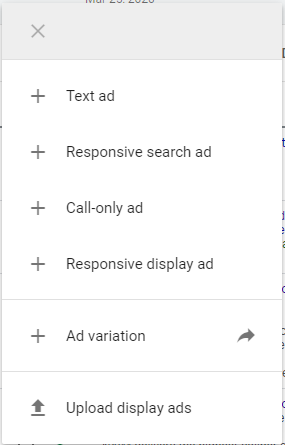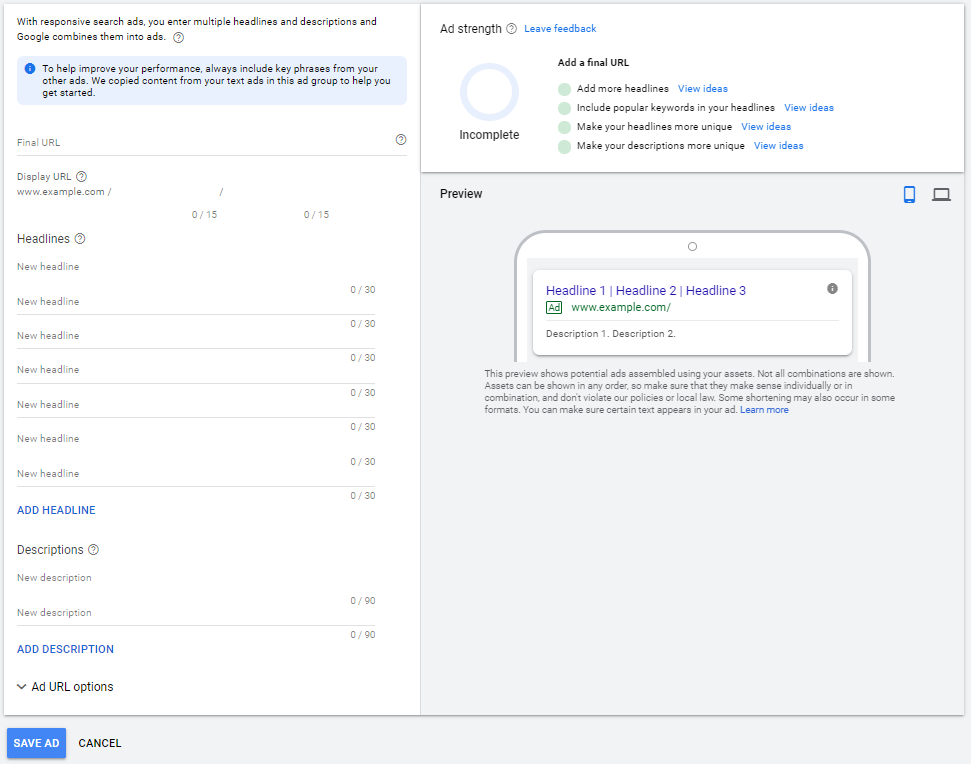Discover the subtle differences between Expanded Text Ads (ETAs) and Responsive Search Ads (RSAs) on the Google Ads platform. Learn how ETAs allow you to fully control your ad copy, while RSAs leverage Google's machine learning to optimize ad responses to specific queries.
Key Insights
- Expanded Text Ads, or ETAs, are traditional Google Ads that permit three headlines and two descriptions per ad, each with character limits. These ads give users full control over their ad copy.
- Responsive Search Ads, or RSAs, represent a newer ad format in Google Ads. They offer greater flexibility and automation by providing up to 15 headlines and 4 descriptions.
- RSAs are designed to adapt to queries or indicators. Google's machine learning algorithms combine, reorder, and select variations of headlines and descriptions to match individual queries.
- RSAs aim to increase ad relevance, thereby improving their chances of appearing in more auctions. This is achieved by tailoring the ad to each specific search.
- While RSAs can help improve relevance and quality score, it is crucial to actively manage their performance. This ensures that participation in increased auctions leads to profitable conversions.
- Using a mix of ETAs and RSAs is recommended. This combination allows for optimized ad performance, as ETAs target known high-performance areas, while RSAs capture miscellaneous searches.
What are Responsive Search Ads? We'll go through what they are, why you should be using them, and how to use them for optimal performance in Google Ads.
Responsive Search Ads is a relatively new feature from Google Ads that brings machine learning into ad copy optimization. Let’s take a step back to understand the difference between Expanded Text Ads and Responsive Search Ads.
Expanded Text Ads
Expanded Text Ads (ETA’s) are your traditional type of ads in Google Ads. With ETA’s you can choose three headlines and two descriptions for each ad you create. Each headline can be up to 30 characters and each description can be up to 90 characters, an upgrade from the old format, the reason for the “expanded” in ETA’s. When you create these ads, you can preview them and see exactly what they will look like in the search engine and that will not waver. Seems ideal, right? You get full control of what your ads say. Enter RSA’s, or Responsive Search Ads.
Responsive Search Ads
RSA’s are a newer type of ad in the Google Ads platform that allows a little more flexibility and automation. Responsive Search Ads are responsive, meaning they can change in response to a query or other indicator. The way this works is that these ads allow for up to 15 headlines and 4 descriptions, and then the ad can combine, reorder, and choose different variations to best respond to each individual query. The goal of RSA’s is to use machine learning from Google to automatically create the best ad for each individual search and, as a result, show up in more auctions because of higher relevance. Essentially, Google will use the list of inputs for the RSA to configure an ad that is more likely to show up for a given search.
Example
Say we are in the watch business and we are bidding on the keyword “+watches.” We might create an ad for this keyword that says “Best Watches | Shop Online Now…” If someone were to search “quality watches” our ad might be somewhat relevant but not exactly and we may not end up with a good enough quality score to show up for that search even though we have very high-quality watches. Now, let’s say we used Responsive Search Ads and one of our headlines was “High Quality Watches” then Google would likely swap that headline in for that search and we would probably do a whole lot better in the quality score department. Then there is another searcher that is looking for “best value watches” and since we are very savvy and have another headline “Value Watches” Google will swap that one in and again we will do better for that specific search. These are just some simple examples to demonstrate the power of the RSA and why you may want to use it.
When to Use RSA’s
While RSA’s can be extremely valuable, the key purpose they serve is to get you into more auctions by improving relevance and quality score of your ad. This is generally a positive thing, but let’s say you are showing up for a lot more auctions and getting those clicks but you are not actually converting those customers for some reason, then you will be spending a lot more money and generating a much lower ROI, so you need to be careful and stay on top of your performance with RSA’s. It is possible that your RSA gets you into a lot more auctions but some of those auctions are not actually worth being in for your business. It is important to actively manage these RSA’s when starting out and evaluate the performance across different searches.
Mixing RSA’s and ETA’s
Ideally, you should have multiple ETA’s that you know to perform well in each ad group, maybe 2 or 3. In addition to that, you can have an RSA in each ad group that will help you capture those miscellaneous searches that your ETA’s aren’t optimized for. Also, don’t forget to use ad rotation optimization in your ad group to make sure you are optimizing to the best performing ads automatically.
Google Ads Training
Learn more advanced features and strategies to drive your business forward in our Google Ads training classes or see our full Digital Marketing Certificate program.






